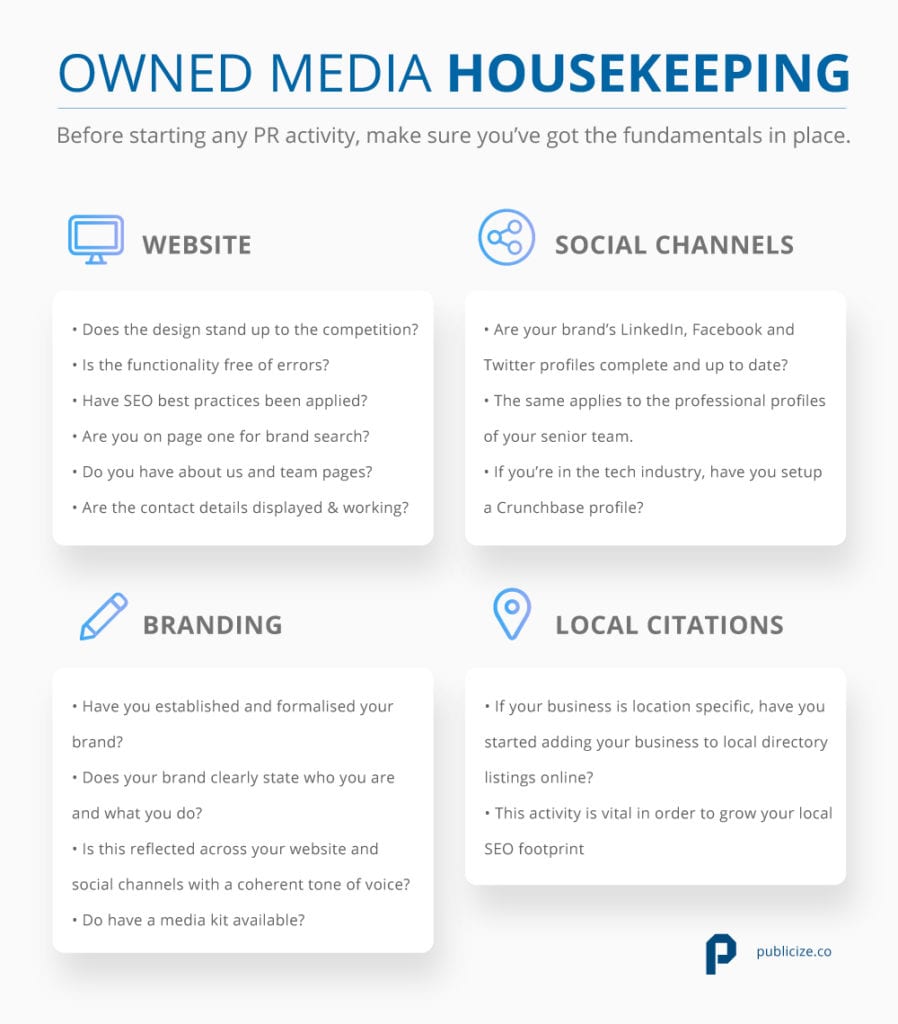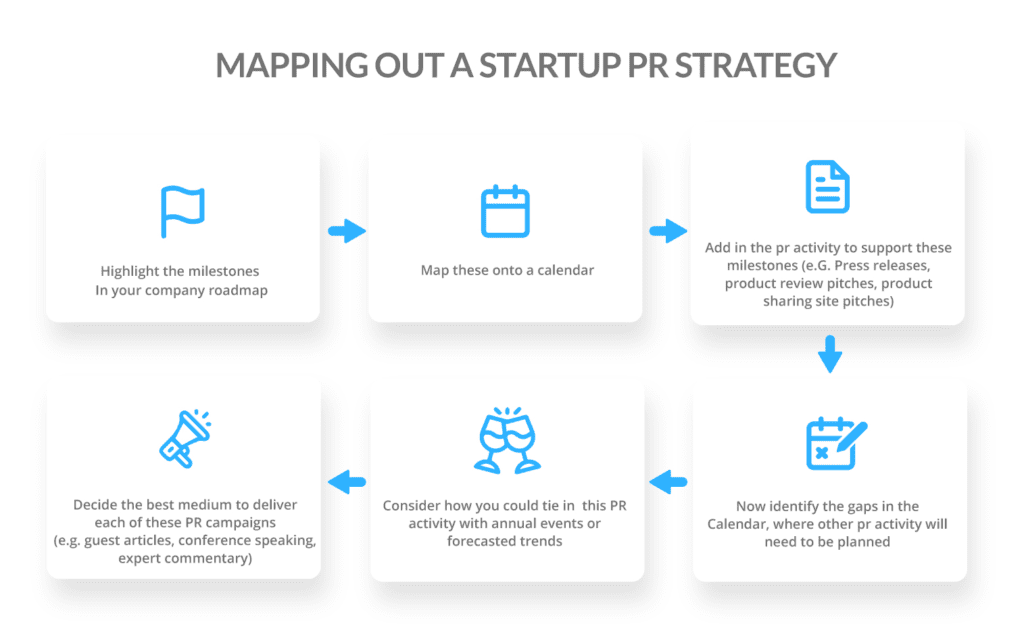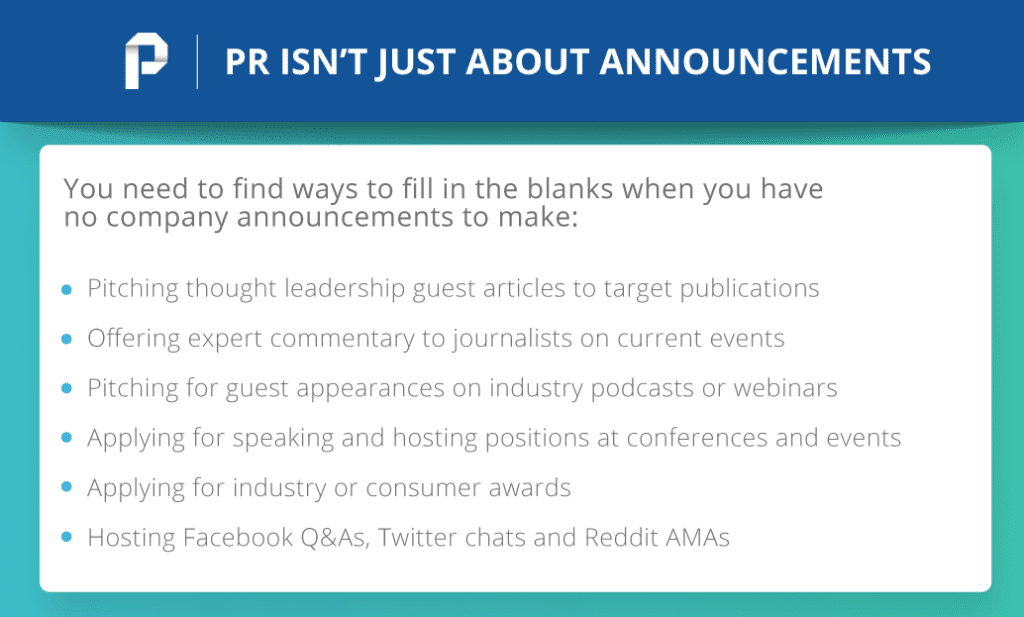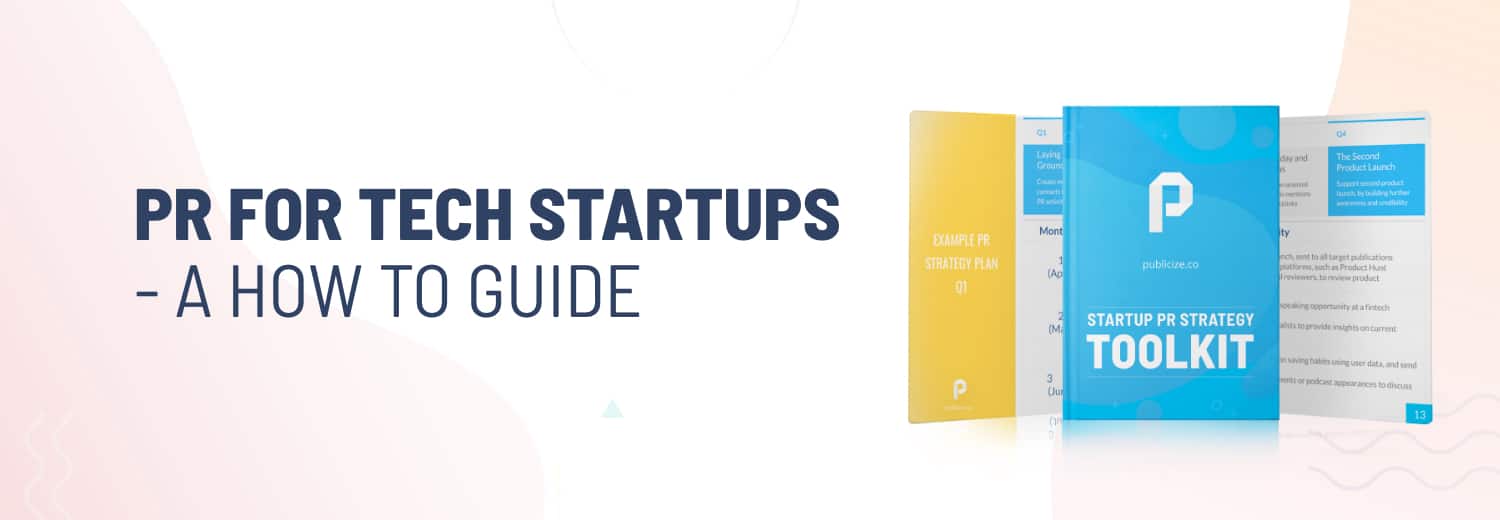It’s often the case that PR for tech startups, or any other startup, is oversimplified or overcomplicated. Some startups think that the sole objective of PR is to bag a story on TechCrunch, while others believe PR to be too intangible or abstract for them to worry about.
Both of these approaches are founded on a misunderstanding of what PR is and what it can deliver.
That’s why we’ve written this startup PR strategy guide, full of super practical takeaways and resources. And it’s based on our experience of managing tech startup PR for thousands of companies over the last 7 years.
In this guide, you’ll learn how to build a winning PR strategy as a tech startup, which includes:
- The benefits of PR for tech startups
- Considerations before you start PR
- How to set media goals
- Writing a startup PR strategy
- The most effective ways to win media coverage
- How to put it all together in the real world

What can PR for tech startups deliver?
We find ourselves having to answer this question a lot. But we get it. As a startup you’ve probably got a super limited budget. It figures that you want to invest your funds in the things that’ll provide the quickest returns. And PR can be pretty low down on the list.
But when applied correctly, tech startup PR can make a huge difference to the fortunes of startups. I’ll explain how by first exploring some common problems.
The challenges faced by many startups
Every tech startup is different. But whether you’re in AI, blockchain, fintech or SaaS, the main challenges are pretty universal and will probably look something like this:
- Securing funding or investment
- Attracting the best talent
- Growing a user or customer base
- Scaling the business
This is where tech PR comes in. A well-planned startup PR strategy can create the foundations required to get you from where you are now, to where you want to be.
Let’s say you’re looking to secure funding. What’s a potential investor going to find when they search for you or your startup? How will this influence their view of you? Ultimately, you need a combination of awareness, social proof and credibility. And PR can help to create these vital foundations with the right type of earned media (that’s a fancy way of saying media coverage).
Or what if you’re trying to grow your user or customer base. Regular marketing, such as Google Ads, is great for driving traffic to a website. But consumers need to first have confidence in your brand. If your brand lacks a credible digital footprint, this is going to make conversion difficult. PR for tech startups helps to create this digital footprint, through media coverage.
We’ve made these examples quite high level, as this guide is focused on startup PR strategy resources and advice. For a much more detailed explanation on public relations as a whole, read our PR for Growth Playbook 2019.
When should a startup begin investing in PR?
“If I was down to the last dollar of my marketing budget I’d spend it on PR!”
Bill Gates
As explained above, tech startup PR can deliver the vital foundations required to grow a business. Therefore, startups should be investing time and energy in public relations from the very beginning.
We know it’s tempting to leave it until the big product launch. Unfortunately, just sending out a press release when your product goes live isn’t going to have much of an impact in 2019.
You need to start building those vital foundations of legitimacy, trust and awareness long before your product hits the market. This is because building these foundations takes sustained effort, over the long term. But the good news is that it doesn’t need to cost you anything other than your time, if you do it yourself.
Setting up your brand
Before you start planning and executing a startup PR strategy, you need to do a spot of housekeeping.
Start with your owed media channels. Your website needs to be the finished article and fully functioning. The same applies to your social media accounts. Use our below checklist to make sure all the basics are in place.

Perfect your messaging
Another fundamental prerequisite is a mission statement. This tells customers, suppliers, journalists, influencers and the general public what you’re all about. And as a startup, educating people on what it is you do, and what you stand for, is crucial.
But this isn’t the only purpose of a mission statement. It also helps to inform the direction of the company, the company culture and employee relations. So think of it as ground zero for growing and building a brand. Without one, all branding and therefore PR activity will lack focus and coherence.
A mission statement should be front and center in your media kit. As well as a mission statement, a good media kit will contain everything a journalist needs to know about your startup. It also helps assist the narrative you’re trying to build through your startup PR strategy.
Therefore, it’s vital you have a mission statement and a media kit finalized before planning or executing a tech startup PR strategy. The PR strategy template in our our Startup PR Strategy Toolkit provides advice on how to write a mission statement and a media kit template example.

How to create a PR strategy
Once the above is in place, you can begin planning your startup PR strategy. Break this process down into two steps:
- Set media goals
Your media goals determine which types of publications you reach out to, as well as the narrative you seek to build. They’re determined by your business goals. Common business goals include securing funding, launching a new product, or growing a user base. Media goals are then created to support these. Here are some examples:
Business objective: Get out the gate
Media goals:
- Credibility: If your startup is in the embryonic stage and your objective is just to get set up, then a startup PR strategy should start building credibility, from day one, long before you’ve won your first customer or spent your first dollar on marketing.
- Social proof: From day one start building up the evidence that you and your company are experts in your field and are to be taken seriously in the industry.
____________________________________________________________________________
Business objective: Secure investment or funding
Media goals:
- Social proof: What will a potential investor find when they search for you or your company? How will what they find influence their decision on whether or not to invest?
- Awareness: Grow eyeballs on you and your brand, by getting featured in the right media outlets.
____________________________________________________________________________
Business objective: Grow customer or user base
Media goals:
- Credibility: What’s the online footprint of your brand? The research phase of the buyer decision process is more important than ever and if your brand lacks a credible online footprint this makes conversion difficult, increasing the costs of your marketing efforts.
- Improved organic search rankings: Move up Google search rankings for popular terms, increasing your traffic and new business potential.
By defining your media goals, your startup PR strategy will have direction. You’ll know what you’re trying to achieve with your media coverage and the types of media outlets you should target. This allows you to move onto the second step.
- Plan media activity
Fail to plan, plan to fail. A trite cliche, but completely accurate when it comes to a PR strategy. Okay, a lot of PR is about responding quickly to current events and capitalizing on trends. That type of activity can’t be planned months in advance. But a plan (subject to regular changes) is still crucial.
We find tech PR plans based on a 12 month time period are the most effective. It allows you to map out your roadmap milestones along with all the seasonal events that are relevant to your industry. You can then start thinking about the PR activity you can do, to capitalize on this.
The below infographic summarizes how to start planning a startup PR strategy:

Get started by overlaying it with your company’s roadmap and add in any key dates. This should include beta launches, full product launches, major releases and any promotional events you may have already planned outside of your PR strategy.
If, following this, you only have one or two dates in the calendar, don’t worry. This is to be expected. Now it’s time to start putting in promotional activity to support these company milestones. The starting point will usually be writing and sending a press release for each milestone. But build out from here. For example, if you’re launching a product you may want to pitch it to product review sites like engadget.
Now your tech startup PR plan includes your company milestones and the PR activity to support these. This enables you to start filling in the blanks, those periods of time when you have nothing to announce. To win earned media during these periods, you need to be creative. Here are some of the things you could consider doing:

Our Startup PR Strategy Toolkit features an example PR plan and a step-by-step guide on how to complete it. Download it here.

Winning media coverage and exposure
A plan is nothing without execution. So once you’ve mapped out your startup PR strategy, you need to begin executing it.
Choosing the right media
Go back to your media goals, to inform which media outlets you should target. Think about the target audience you need to reach, in order to achieve those goals. You need to target the media outlets consumed by this audience.
Here are some examples of how your media goals will determine which media outlets your startup PR strategy should target:
- Media goal: build social proof to help secure funding
- Target media outlets: trade journals, industry magazines and conferences
- Media goal: grow credibility to help increase user base
- Target media outlets: tech blogs and publications, professional review sites and consumer tech shows
- Madia goal: increase organic traffic via backlink growth, to help increase sales
- Target media outlets: blogs, news and industry sites with good domain authority scores and content relevant to your product
You should always aim to identify and approach relevant journalists, bloggers or event organisers directly. Always avoid sending a pitch to a general enquiries email address. Here’s a step-by-step guide on finding journalists’ contact details to help you get started.
Build relationships first – pitch second
Building relationships with journalists and other influencers is crucial. You need to put energy into doing this from day one. But do this right and you’ll then a have a number of journalists warm to you when you start executing your PR plan.
Here’s the golden rule we stick to with this:
Ask not what a journalist or influencer can do for you, but what you can do for a journalists or influencer
In other words, you need to give me than you take. In terms of getting your foot in the door, here are some tried and tested methods:
- Networking at events and conferences. For maximum exposure, try and combine it with a speaking opportunity.
- Get an introduction, the startup ecosystem is great for this type of mutual support.
- Engage in social media and forum discussions.
- Offer an expert comment on a news story that you can demonstrate your authority on.
Perfect the Pitch
When developing a pitch, first evaluate how newsworthy it is from a journalist’s perspective. There are many ways to measure this, but we like to assess it with these 5 factors:
- Timing
- Significance
- Proximity
- Prominence
- Human interest
Understanding how well a pitch meets this criteria will provide you with a realistic idea of which publications you should reach out to. If your pitch is a 9/10, then you can pitch it to major publications relevant to your target audience. This could include Forbes, Entrepreneur, or perhaps TechCrunch. If you assess that the pitch is only a 3/10, it would be wiser to aim for coverage in industry vertical publications.
And as for the actual pitch email, keep it short and sweet. Explain why it’s relevant, how it relates to a current news story or trend, and what unique insights it brings. Here’s an example pitch of an offer of expert commentary to a journalist:
Subject: {{journalist_first_name}}, Expert Commentary: Challenges for Recruiters With Lowest Unemployment Rate in 50 YearsHi {{journalist_first_name}},
I’m writing to offer you some expert commentary and data on the following story;
With the lowest unemployment rate in nearly 50 years, candidate behavior is changing and presenting new challenges for recruiters. The cost of recruiting your average non-skilled worker has risen significantly, with CPC (cost-per-click for job ads) up by 22 percent.
John Doe, CEO of machine learning and AI recruitment platform Go Recruit Me, is an expert in the space. He’s experienced first hand similar pains — his company has seen a 30% increase in CPC on job ads.
He would be happy to provide commentary on the new challenges recruiters face in this context including:
- The challenges in recruiting for non-skilled positions vs. skilled
- The “magic window” – after 72 hours, companies are losing candidates at a rate of 15% per day
- Tools recruiters can use to meet these challenges, including AI
- The phenomena of “candidate ghosting”
Please let me know if you’re interested in commentary, an interview, or a bylined contribution and if so, how you would like to proceed
Many thanks

Putting it all together
When it comes to PR for tech startups, putting it all together can seem daunting at first. So here are model examples of three different stages of a tech startup along with how to create a pr strategy for each.
Initial stage startup – getting out the gate
Unfortunately, the act of launching a startup isn’t news. A conventional press release announcing a tech company launch will have very little chance of generating any media coverage.
But there are plenty of other ways you can start building a media footprint. Focus on the human element. What’s the story of why the startup was founded? What are the founders backgrounds? What inspired them to do this?
Develop a narrative about your startup that’s original and inspirational, then pitch this to the media. And whatever you do, definitely do not say your purpose is “to disrupt the industry”.
The next step is to leverage the experience of the founder or the leadership team. What can you provide expert advice or commentary on? Link this to current trends or news stories, then pitch the offer of writing guest articles to target publications and blogs.
Of course, all of this needs to be linked back to your media goals. These could be things like building legitimacy and credibility, in order to attract staff and secure funding.
Early stage startup – the product launch
A product launch press release is definitely a wise first step here. But to get the media coverage that you probably desire, you need to go much further with your tech startup PR efforts.
Look towards product sharing sites for to build more exposure for your product launch. Platforms such as Product Hunt, Launching Next and BetaList all accept pitches/applications from startups. Getting featured on one can drive thousands of users to your site in a single day.
The next target on your startup PR strategy could be professional product review sites. Websites such as Engadget, CNET and Wirecutter are common startup PR strategy targets.
The above activities are all explicitly promotional. But there’s also plenty of non-promotional activity you can do, in order to achieve your media goals. Think about how your product could tie into a current trend or news story, which would allow you to provide expert commentary or insight.
Some recent examples we’ve had of this include a 3D printing user management software company providing commentary on how to control the 3D printing of weapons. And the CEO of a travel insurance company providing insight on the health of low cost European airlines following a number of bankruptcies.
Growth stage startup – user acquisition
You’ll no doubt have other marketing activity in place by this stage. So typical tech PR media goals will be things like building credibility and awareness, to support these marketing efforts.
Conventional marketing, such as digital ads, is great for driving traffic. But if your brand isn’t seen as credible you’re going to struggle to convert this traffic into customers or users. Consumers crave trusted brands. And trust generated via earned media far outweighs anything that paid media can deliver (as survey after survey show).
Consumers want to find more than just your website and your social channels, when they search for your brand. Winning plenty of media coverage will help to build your digital footprint. This is fundamental in building trust and legitimacy in the eyes of consumers – it’s not what you say about your product or brand that matters, it’s what others say.
One way to do this is to position yourself and your company as a thought leader within the industry. This can be achieved through regular guest articles submissions to top tier publications and providing opinions and expert commentary on any current affairs or trends that are relevant to your product.
And the more earned media you win, the more natural backlinks you’ll gain. This will help you rise up Google’s search results which will provide a further boost in hitting your user acquisition targets.

And remember – PR doesn’t happen in a vacuum
The good news is that tech startup PR is closely related to a lot of other activity you’re probably already doing or plan on doing in the future.
Take content marketing, for example. For many startups, this will be a central tenet of their marketing strategy. This content is also incredibly valuable when it comes to tech PR. Reach out to journalists or other influencers whenever you publish something original and insightful. This could be anything, such as a piece of original research or an infographic on the future of your industry.
When it comes to SEO, as mentioned above, PR now plays an integral role in natural backlink building. This means a link building strategy can be combined with a startup PR strategy, to save both time and money.
And as for networking and knowledge sharing within the startup eco-system (one of the greatest assets of startup culture), this provides plenty of PR opportunities. This includes meeting journalists and influencers and being invited to give talks at conferences or workshops.
So now you know the basics of PR for tech startups. Take this one step further by downloading our Startup PR Strategy Toolkit. This includes a PR strategy template example, a media kit template example and a startup PR checklist.





